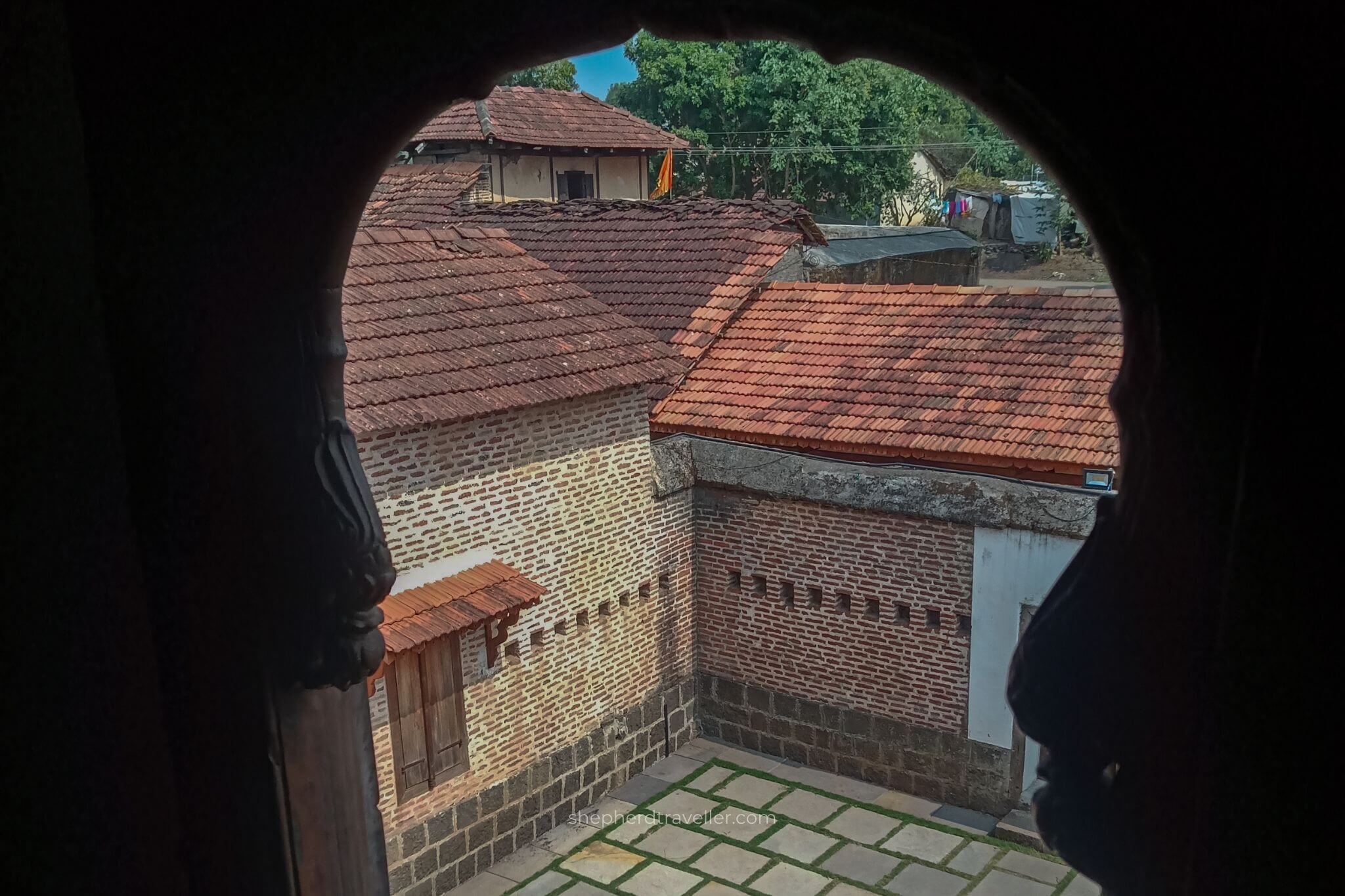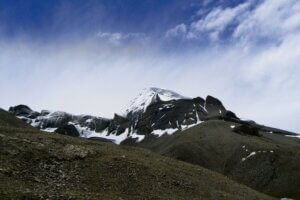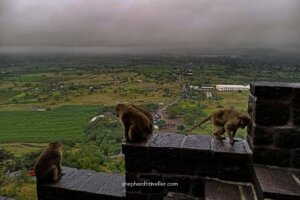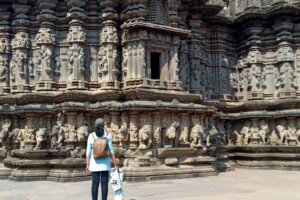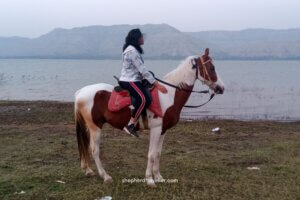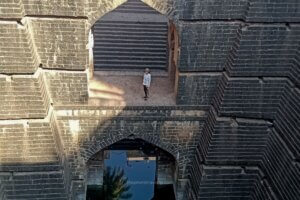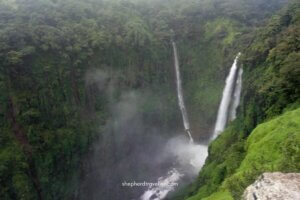Nana Phadnavis Wada is the most beautiful piece of old Maratha architecture located in western Maharashtra in India. In spite of being more than 200 years old, the wooden architecture is still well preserved. You must visit this mansion to experience the genius architecture styles and the glorious history from the time of Chp. Shivaji Maharaj. Also, visit the Menavali ghat which is a beautiful riverbank located just behind this Wada.
Wai is a quick getaway from Pune, Satara and Mahabaleshwar. If you are travelling in this area, you should include this place in your trip. I reached the Wai bus stand a bit later than I had planned. And then made my way towards this Wada first, before exploring the other places in Wai.
This was the first day out of my 21 days solo trip across Maharashtra.
Quick details about Nana Phadnavis Wada and Menavali Ghat
- Best time to visit: Any time of the year, but the monsoon will definitely be more beautiful.
- Timings: 9.00 am to 5.30 pm
- Entry ticket: Rs 30 (for both Indians and non- Indians)
- Photography fee: Rs 20 for mobile camera and only photos allowed. For videography and camera equipment separate permission has to be taken from the officials.
- Parking fees: Rs 10 for two-wheelers, Rs 30 for cars, and Rs 50 for large vans and buses.
- Washrooms: Available.
- Where to eat: Nothing much available near the wada as it is located inside a village. You can get some authentic Maharashtrian food in Wai, or head over to Mapro garden in Panchgani for food like sandwiches, fries, pizza and strawberries with cream.
- Accessibility: The Wada is not accessible to wheelchairs as there are some steep old stairs inside.
Check out our Ebook on – 108 Shiva Temples in Pune
How to reach Nana Phadnavis Wada
The best way to reach here is by your own vehicle bike or car. The roads here were in fantastic condition when I visited. If you want to go by public transport, then the nearest bus stand is Wai. From here you have to take an auto-rickshaw to the Nana Phadnavis Wada.
- Pune to Nana Phadnavis Wada distance: 92 km or 2 hours.
- Satara to Nana Phadnavis Wada distance: 40 km or 1 hour.
- Panchgani to Nana Phadnavis Wada distance: 17 km or 0.5 hours.
- Mahabaleshwar to Nana Phadnavis Wada distance: 36 km or 1 hour.
Who was Nana Phadnavis?
The real name of Nana Phadnavis was Balaji Janardhan Bhanu. The Maratha empire flourished and expanded under the leadership of Chp. Shivaji Maharaj. At this time, several Peshwas or Prime ministers were appointed by the king. The kingdom also needed someone to manage the accounts and administration – A Phadnavis (finance minister). So Balaji Bhanu, a person from Konkan was appointed as the Phadnavis or the chief accountant of the Maratha empire. Since then he was always referred to as the Phadnavis rather than his real name Bhanu.
After Nana Phadnavis was given several lands in this little village of Menavali, he built this beautiful Wada (mansion) for himself. During his lifetime he was successful in keeping the British at bay. He formed the Barabhai council – a council of 12 men to keep the Maratha empire and young Madavrao II safe from the internal conflicts of Marathas and the external threat of the Britishers. The Maratha empire really flourished during his time and it collapsed after his death.
The Architeture style of Nana Phadnavis Wada
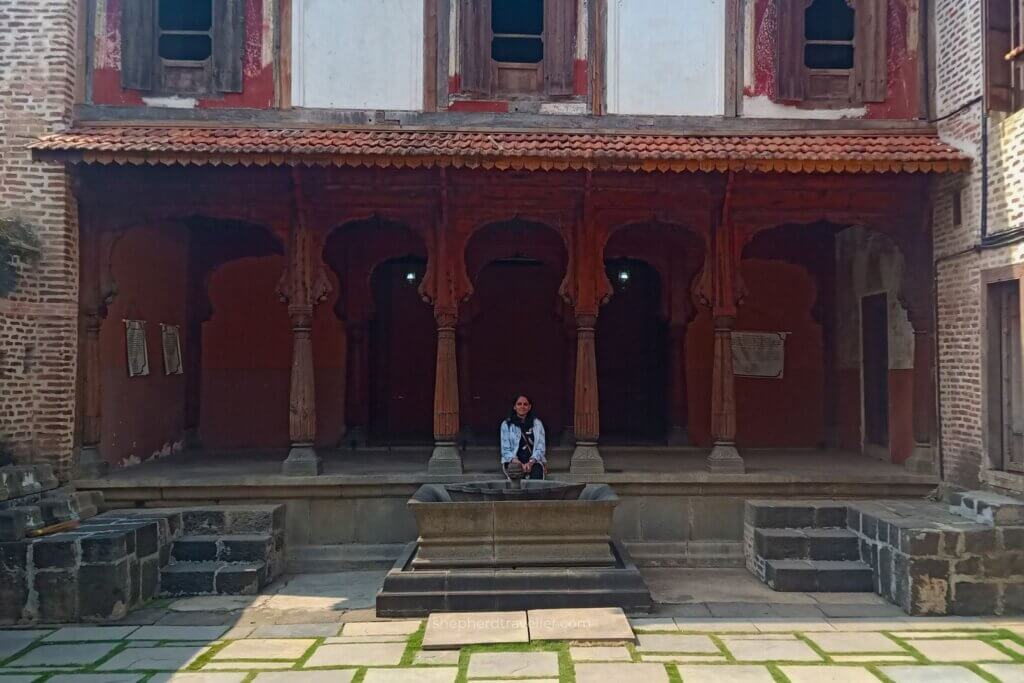
Most of such pre-independence architectures in India have been demolished or lost at the hands of the British or the government. But this structure is well preserved and it now belongs to the descendants of Nana Phadnavis. While most of this Wada or mansion is sealed off and kept private, the descendants show off a small part of the Wada to tourists and the general public.
Once you walk into this Wada you are entering another era. The architecture at Nana Phadnavis Wada gives a rare insight into the ingenious architecture styles used by the ancient Marathas. The intricate lattice carved in wooden ceilings, the beautiful pillars and wall paintings will surely leave you amazed.
The main door, the perimeter wall and turrets or buruj on all four sides resemble the architecture of several forts that were built or reconstructed during the era of Chp. Shivaji Maharaj. But the inside of the Wada resembles the Konkani style of architecture.
These centuries-old wooden carvings and paintings are still preserved and look amazing even today. As I entered the Wada the guide here started telling us the information about Nana Phadnavis and about this Wada (mansion). She was a young girl just about my age. And she told us everything about the Wada with much gusto.
Following are some important things to see inside the Nana Phadnavis Wada.
Nagarkhana and Ganesh Chowk
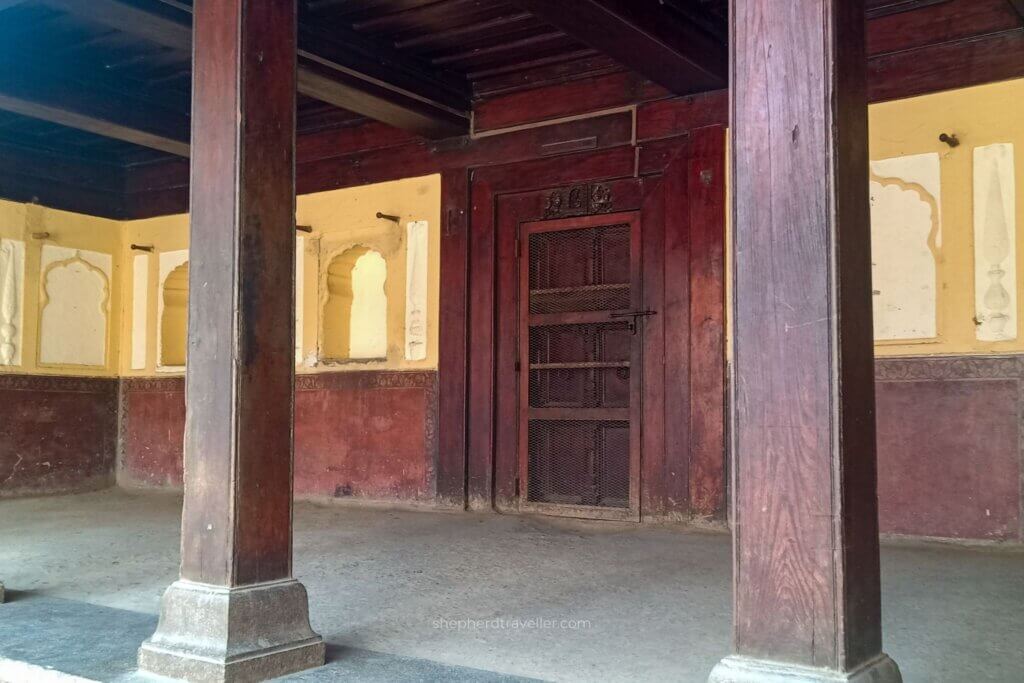
Nagarkhana is a place from where they used to make announcements or play music in the olden times. This was done only on special occasions, festivals or on the arrival of important persons. It is a small but high raised platform just above the main gate.
As I climbed up the steep musty staircase to the top, I was amazed at the view from the windows here. I could see the Wada itself from the top on one side. On another side I could spot the Pandavgad fort in distance on the horizon. And I could just imagine how beautiful this place must be in the olden times.
As you enter into the Wada you first come to the Ganesh chowk. A beautiful little replica of Ganesh murti stands here at the entrance. A staircase from near the Ganesh Chowk leads straight up inside the Nana’s Diwankhana or hall. I personally found the upper floors to be more interesting and exciting than the ground floor.
Nana’s Diwankhana and Bedroom
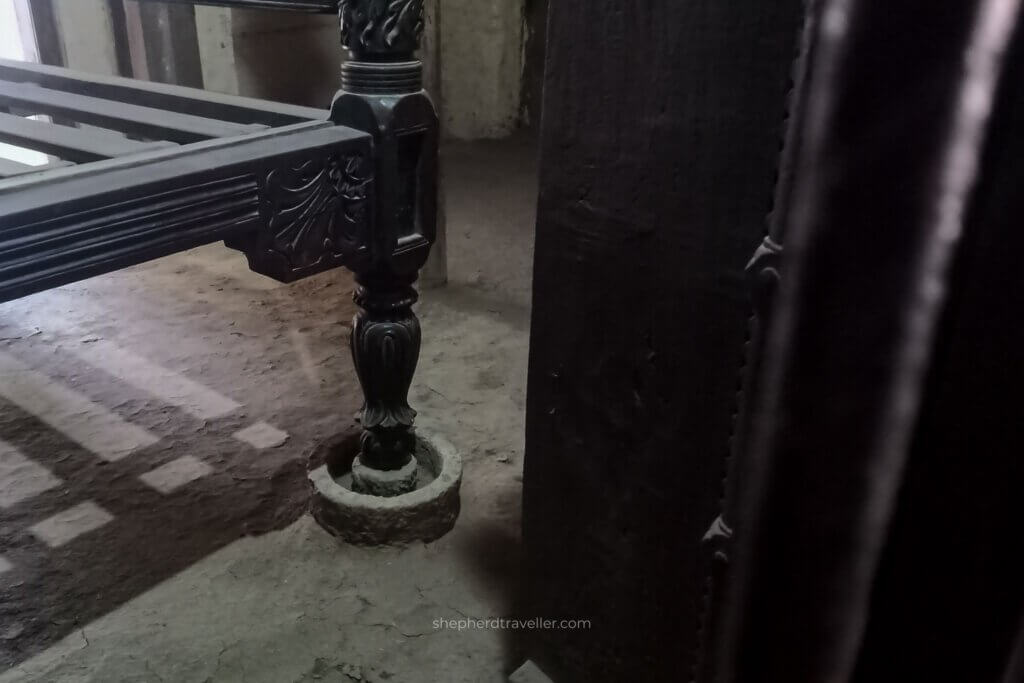
The bedroom of Nana Phadnavis is attached to a stately Diwankhana or a hall. While walking around this Diwankhana make sure you look at the ceiling and the cute wooden carvings on the pillars. The attached bedroom is sealed off, but you can take a look inside. Nana Phadnavis used to sleep on this cute four-poster bedstead made out of teakwood. The floor is covered with cow dung even today. And there is a hand operating cloth fan at the top. Look at the legs of this bedstead, there is a circle made around them. They used to fill it with water so that ants, termites or other rodents cannot climb up or eat up the majestic wooden bed. How genius!
Pangaticha Chowk and rain water harvesting
Pangaticha Chowk (courtyard) is where they had their kitchen on the ground floor. The water system here is very impressive. You can see that there are wooden studs on all four sides of the roof. The water on the roof drops down from these studs in heavy monsoon. There is a nice channel made for the water to flow away, down below. Just a little ahead are five holes in the ground. The rainwater goes straight to the Krishna river flowing behind this Wada.
Menavali Daftar and letters in ancient Modilipi script
Menavali Daftar is the official administrative space on the upper floor of Pangaticha Chowk. All the financial and administrative documents of the Maratha empire were maintained here at Menavali Daftar by Nana Phadnavis. Even today they have several such important documents, written in Modilipi script, which was the administrative language at the time. It was amazing walking at this place, from where there managed the finances and administration of the Maratha empire. At the end of the tour of this Wada, before leaving, they will write your name on your entry ticket in this Modilipi script as an ode to the olden times.
Khalbatkhana or Secret meeting room
There are two hidden passages leading into this secret room. One hidden passage leads you in this room from the Diwankhana or Nana’s hall. And there is another hidden entrance through a cupboard in the Kaladalan or the art room. A secret escape staircase is also located adjacent to this room. This room was used for the secret meetings by Nana Phadnavis and his men. The room has very thick walls and extra wooden panels on the ceiling so that not even a whisper can go outside these walls.
At the end of this room is an old gallery, which was originally a part of the Diwankhana. The guide here told us that Nana used to sit down close to this window and look at the view outside. There was an old chair in this room. Can you guess what I did after the guide left? I took this chair and sat in the very same window for a few moments. I looked at the view outside. The Haldi Kunkawacha Chowk is visible just below this window. And I could see some Panchgani mountains in the distance.
Kaladalan or the art room
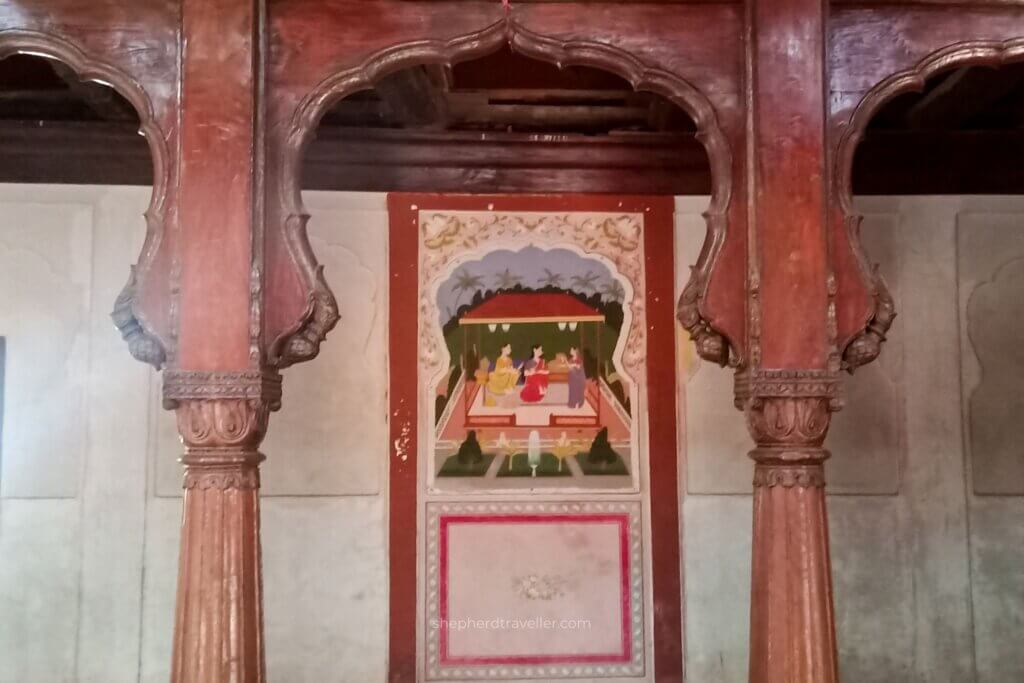
Kaladalan or the art room is located right next to the Khalbatkhana. There are a few beautiful wall paintings left in this room. Nana Phadnavis had a great taste in art and wall paintings. He called upon several renowned artists and painters of the time to paint the glossy walls of this mansion.
The most renowned painting where Sita (from the Hindu epic Ramayana) is dressed in Maratha clothes can be found here. Some of the paintings are on the verge of destruction due to the cracks in the walls. And the best ones are taken off by them and preserved somewhere else. Actually, I found that most of the really beautiful paintings are not here anymore. But if you want to see them, then you can find pictures and descriptions of them in the book ‘Maratha Wall Paintings’ compiled by historian Dr B. K. Apte.
The windows of this room are also very beautiful. The windows have cute paintings around them from the outside. You can see that from the Haldi Kunkawacha Chowk (courtyard) below.
The secret staircase
An old, dark and musty staircase is stashed in between the Kaladalan and the Khalbatkhana. The secret cupboard from the Kaladalan or the art room leads to this staircase too. It is so small that only one person can go at a time. The stone stairs are quite high. These stairs take you down to the Haldi Kunkawacha chowk. And there is a back door nearby that leads straight to the Menwali ghat. This secret staircase was an escape route used by Nana Phadnavis and his men in event of unwanted visitors.
Haldi Kunkawacha Chowk
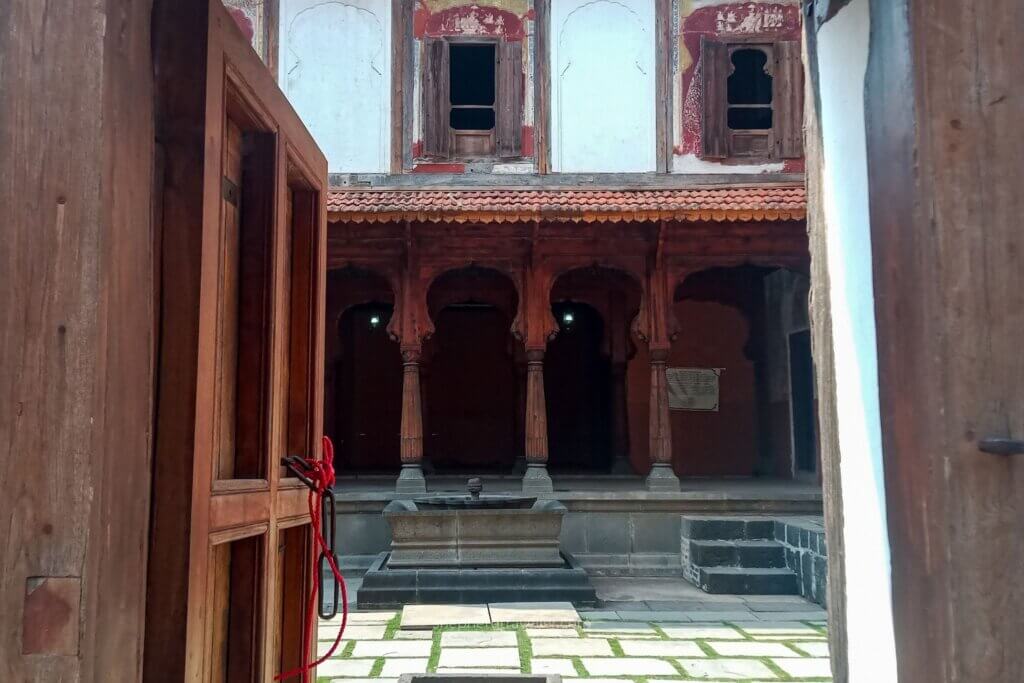
This is my most favourite part of the Wada (mansion). And once you see it, you won’t be able to forget it. Haldi Kunkawacha chowk is the courtyard where the women of the Wada (mansion) used to hang out. It is located adjacent to the Ganesh chowk and has a separate entrance. There are several niches and grooves all around the walls here. Just imagine how beautiful it must look when these niches are light up with oil lamps. There is a small pretty Pushkarni or a fountain inside this courtyard.
As you go inside the rooms close to this chowk you will be amazed by the pretty intricate lattice carved in the wood on the pillars and walls all around these rooms. The design is so small yet very symmetric and uniform.
Motifs in the pillars and their meaning
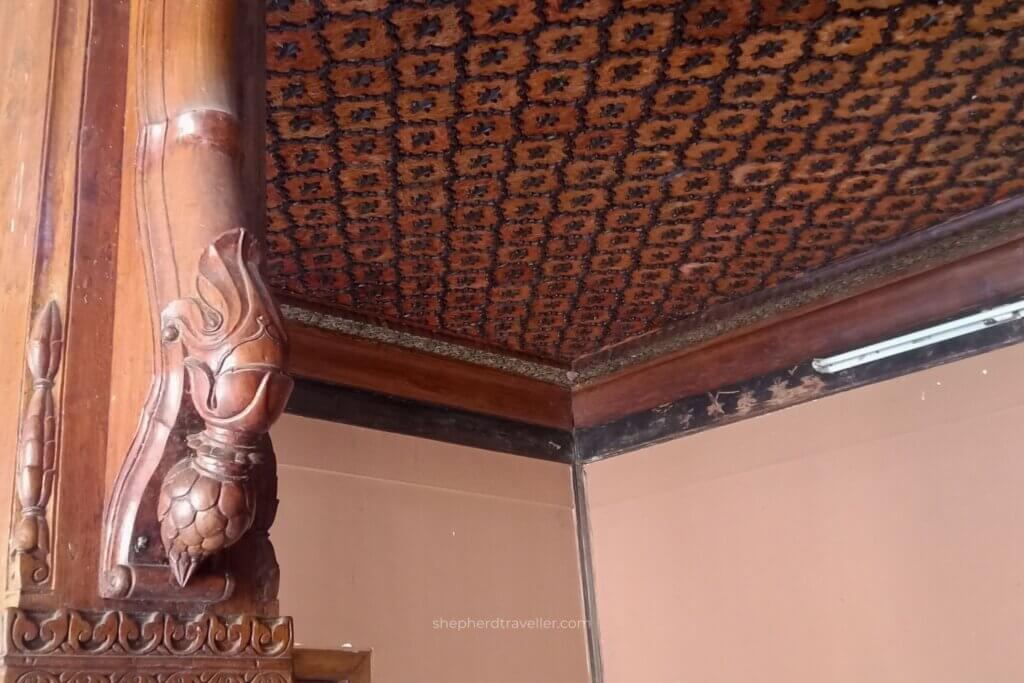
Nana Phadnavis was from Velas – a beach village near Shrivardhan in Konkan. The entire interior of this Wada is inspired by the Konkani style of architecture. Almost every pillar has an intricately carved banana flower. I saw similar banana-flowered pillars in the temples of Konkan which I visited later in this trip.
Courtyards or chowks
Inside this Wada type of architecture, a chowk is a courtyard or a quadrangle. It is basically an open space left at the centre of the Wada with the house on all four sides. This was done to enhance the airflow within the Wada. There are 6 such chowks or quadrangles inside this Wada (mansion). The most beautiful one among them, which is also my favourite, is the Haldi Kunkawacha Chowk.
Baobab tree or Goraksh Chinch at Nana Phadnavis wada
An ancient tree with a large trunk can be seen just outside the Wada. This tree was bought here from Africa for the soldiers of the Maratha army. The tree bears fruits similar to jackfruit and has amazing medicinal properties. This tree is almost as old as the Wada itself.
Menavali ghat
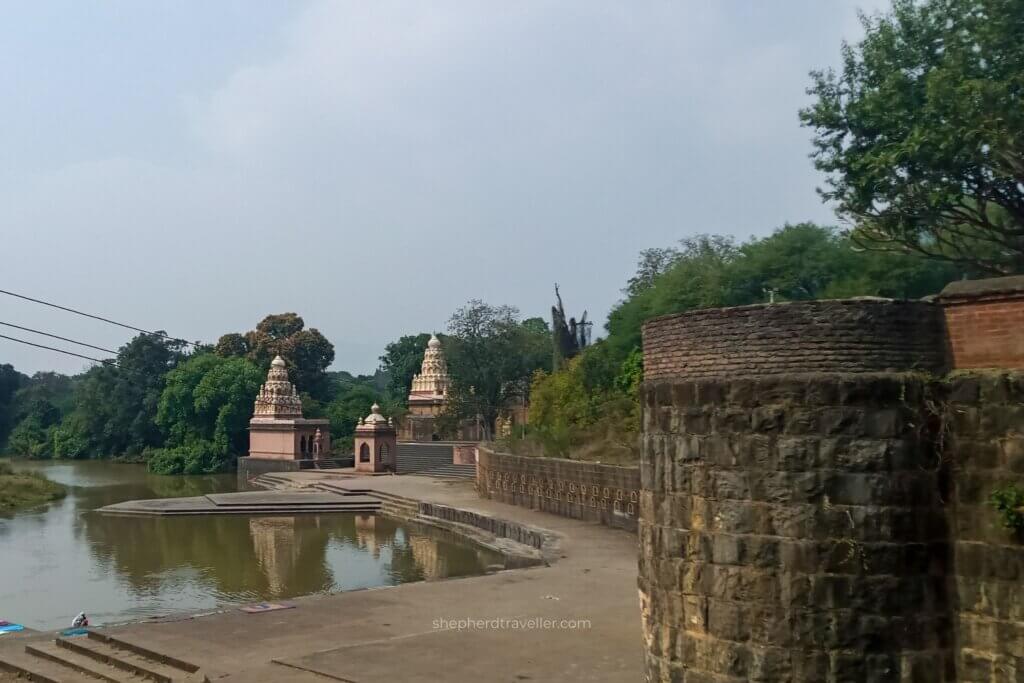
The Krishna River flows behind the Nana Phadnavis Wada. Earlier the ghat had simple stone steps leading down to the river. But as the Maratha empire flourished, they converted it into a beautiful arrangement of terraces. Each terrace or area has a designated purpose like – bathing, washing clothes, filling up drinking water and performing religious rites. Temples were built around the ghat during this same period.
Meneshwar temple, the European bell and a Vishnu temple
Meneshwar temple is located alongside the river on Menavali ghat. it is dedicated to the god Meneshwar (shiva). The idol here is said to be a Swayambhu idol – that is formed by itself. A few uneven steps lead downwards inside the temple. It was very dark, and there was no light inside the temple when I visited.
Outside this temple near the Nandi, you will find a unique bell tower. This is a European bell that was captured from the Portuguese by the Marathas. It was bought here from Vasai fort by Chimaji Appa. And it still hangs here as a reminder of the long-gone battles. The=is bell is made from an alloy of five metals and it weighs 650 kg. There is an inscription on it which I think must be Latin rather than Portuguese. A picture of mother Mary and young Jesus is also cast in this bell.
The Vishnu temple is located close to this Meneshwar temple. But when I asked the locals about it, they said it is closed for tourists. Only the priest opens it to perform the rituals.
Featured in Bollywood movies
The Nana Phadnavis Wada has been featured in several Bollywood movies like Swades, R Rajkumar, Bajirao Mastani, Mrityudand, Gangajaal, and many more.
Places to visit nearby
- Narsinha Temple
- Temples in Wai
- Kas Pathar
- Baramotichi Vihir
- Ajinkyatara Fort
- Thoseghar waterfalls
- Sajjangad Fort
- Dhom Dam
Find more places to visit in Satara here.
